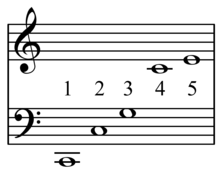This article needs additional citations for verification. (June 2020) |




| Inverse | Minor sixth |
|---|---|
| Name | |
| Other names | ditone |
| Abbreviation | M3, maj3, M3, maj 3 |
| Size | |
| Semitones | 4 |
| Interval class | 4 |
| Just interval | 5:4, 81:64, 9:7 |
| Cents | |
| 12-Tone equal temperament | 400 |
| Just intonation | 386, 408, 435 |
In classical music, a third is a musical interval encompassing three staff positions (see Interval number for more details), and the major third () is a third spanning four half steps or two whole steps.[1] Along with the minor third, the major third is one of two commonly occurring thirds. It is described as major because it is the larger interval of the two: The major third spans four semitones, whereas the minor third only spans three. For example, the interval from C to E is a major third, as the note E lies four semitones above C, and there are three staff positions from C to E.
The intervals from the tonic (keynote) in an upward direction to the second, to the third, to the sixth, and to the seventh scale degrees of a major scale are called "major".[2]
Diminished and augmented thirds are shown on the musical staff the same number of lines and spaces apart, but contain of a different number of semitones in pitch (two and five).
- ^ Forte, Allen (1979). Tonal Harmony in Concept and Practice (3rd ed.). Holt, Rinehart, and Winston. p. 8. ISBN 0-03-020756-8.
A large 3rd, or major 3rd (M3) encompassing four half steps.
- ^ Benward, Bruce; Saker, Marilyn (2003). Music: In theory and practice. Vol. I (7th ed.). p. 52. ISBN 978-0-07-294262-0.